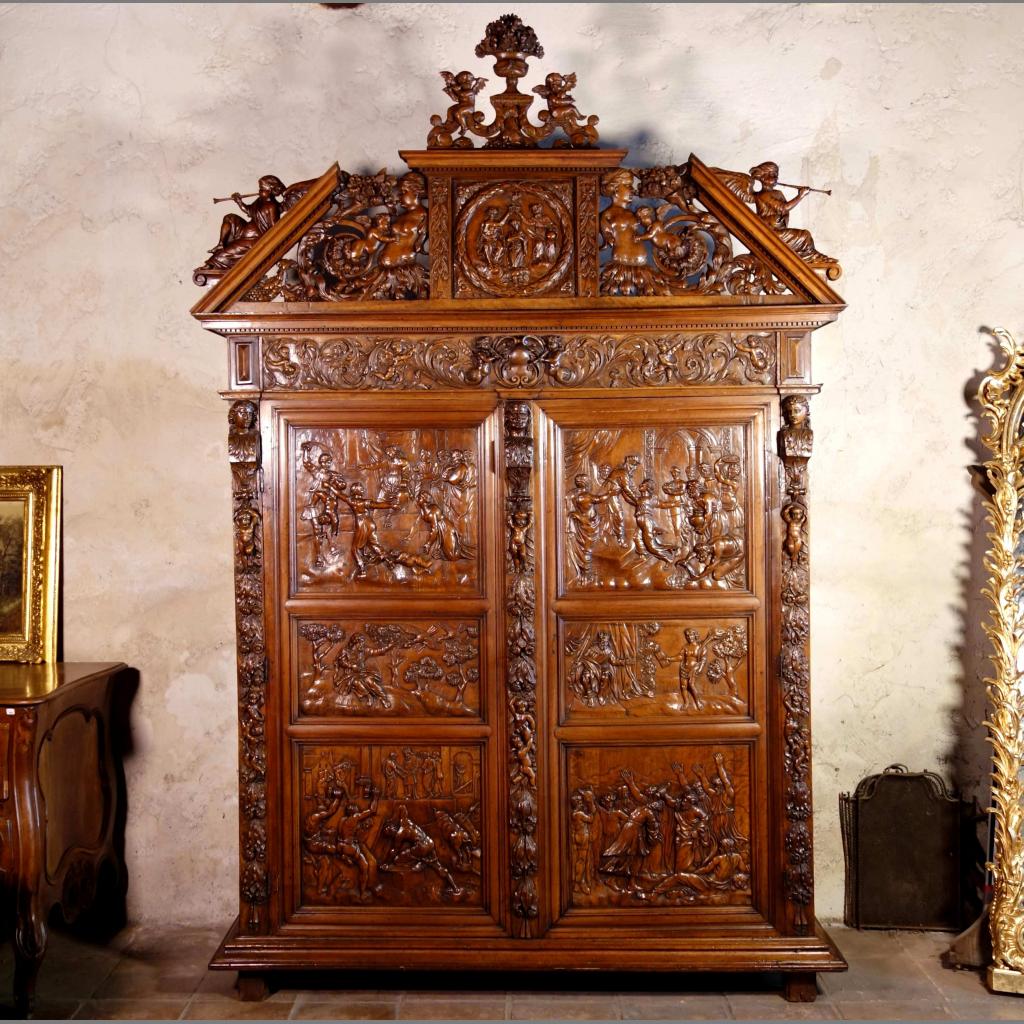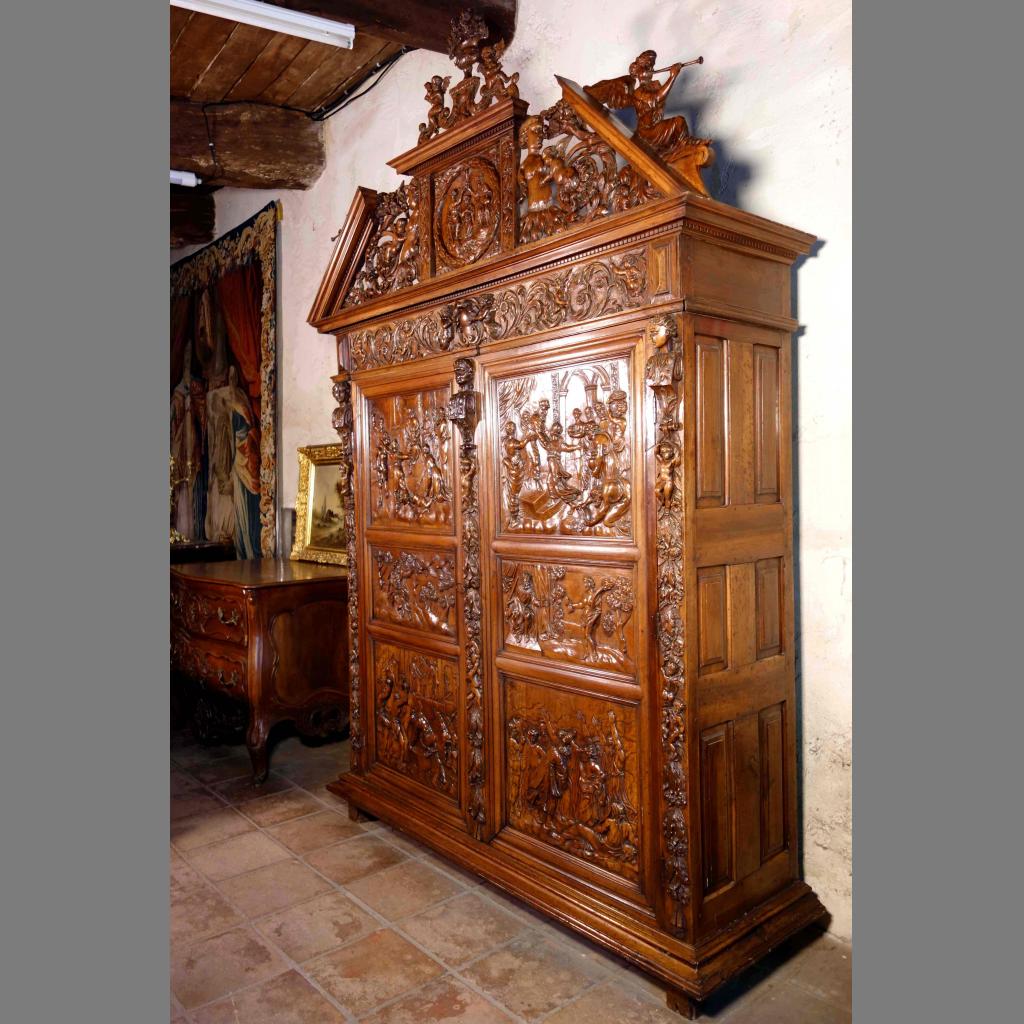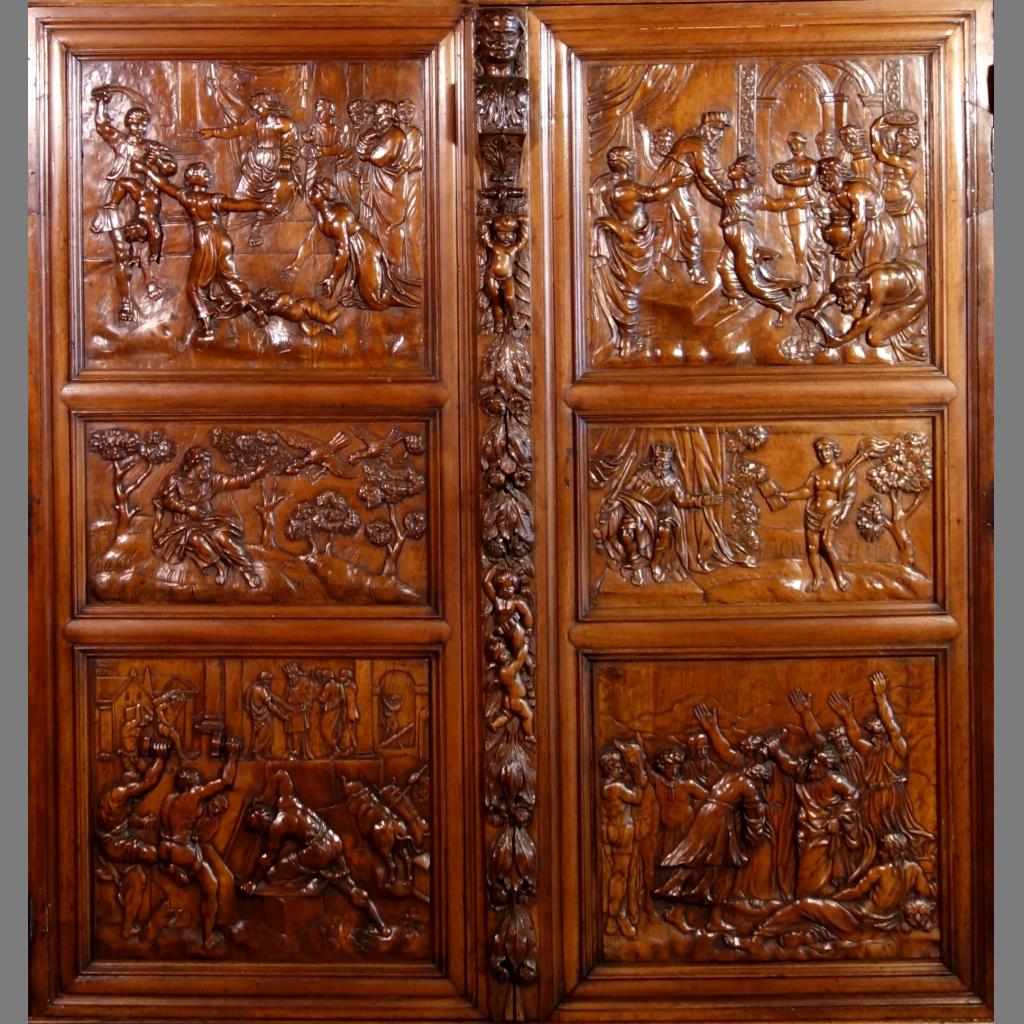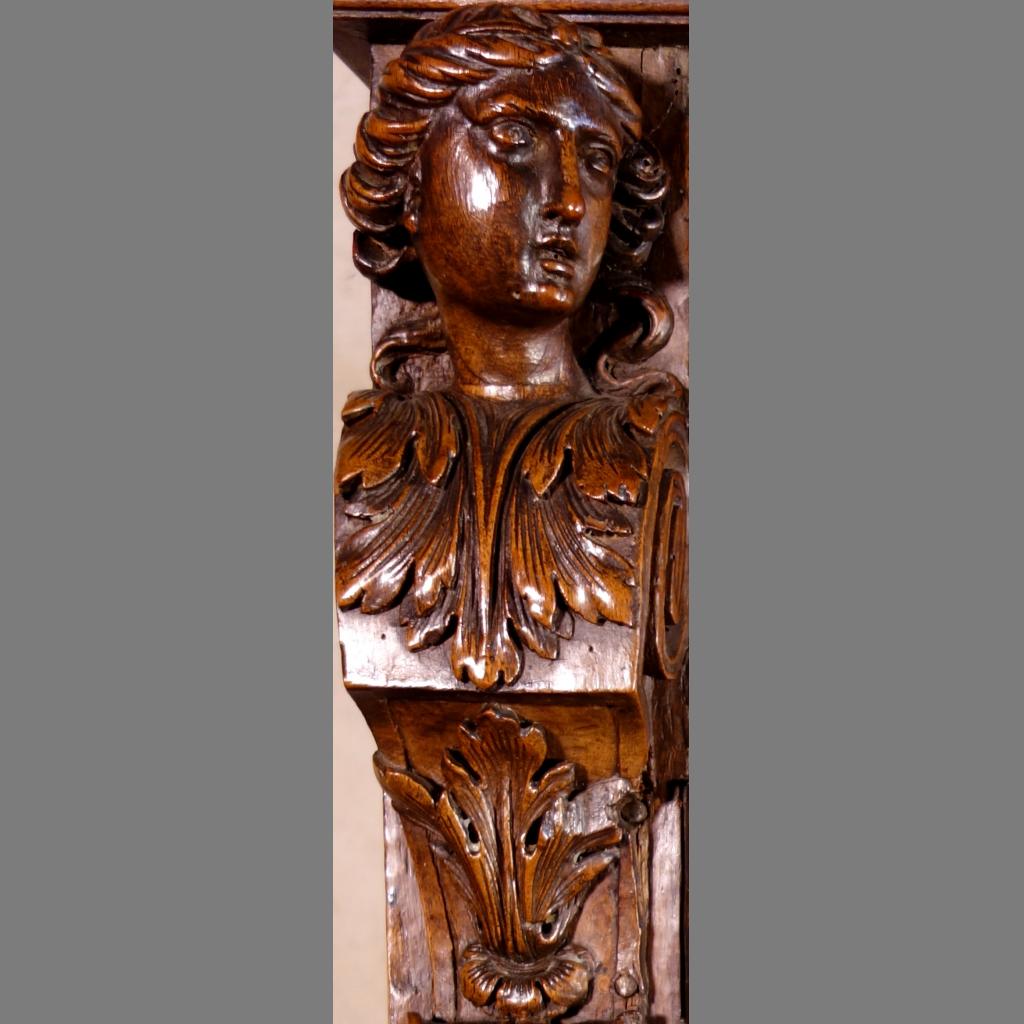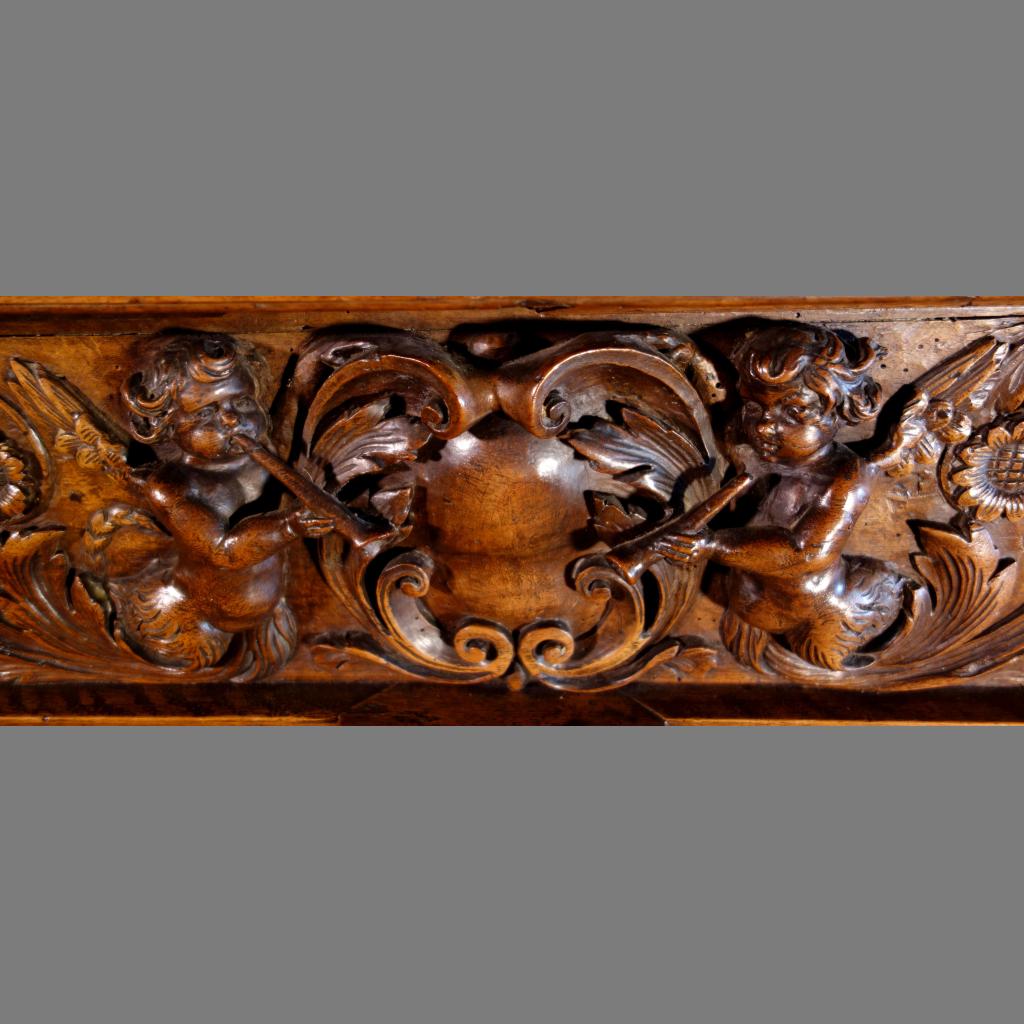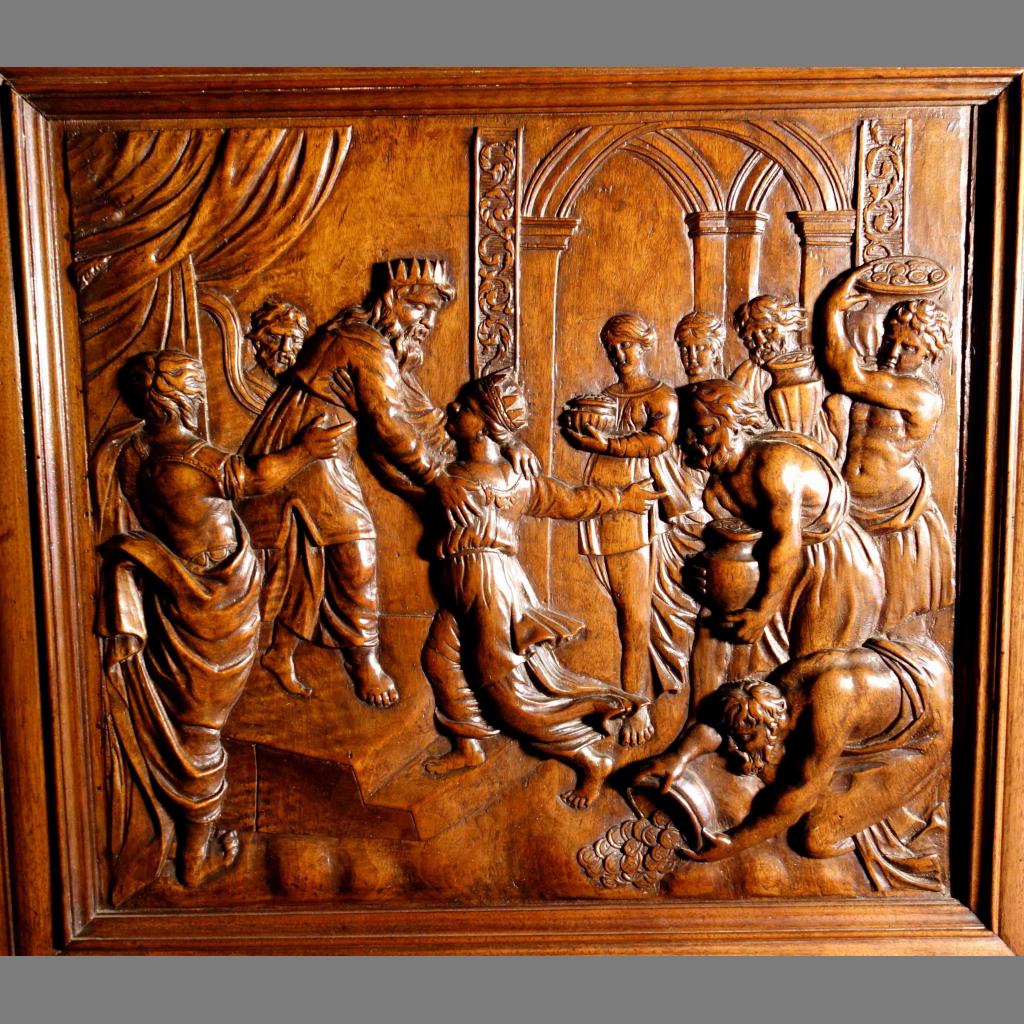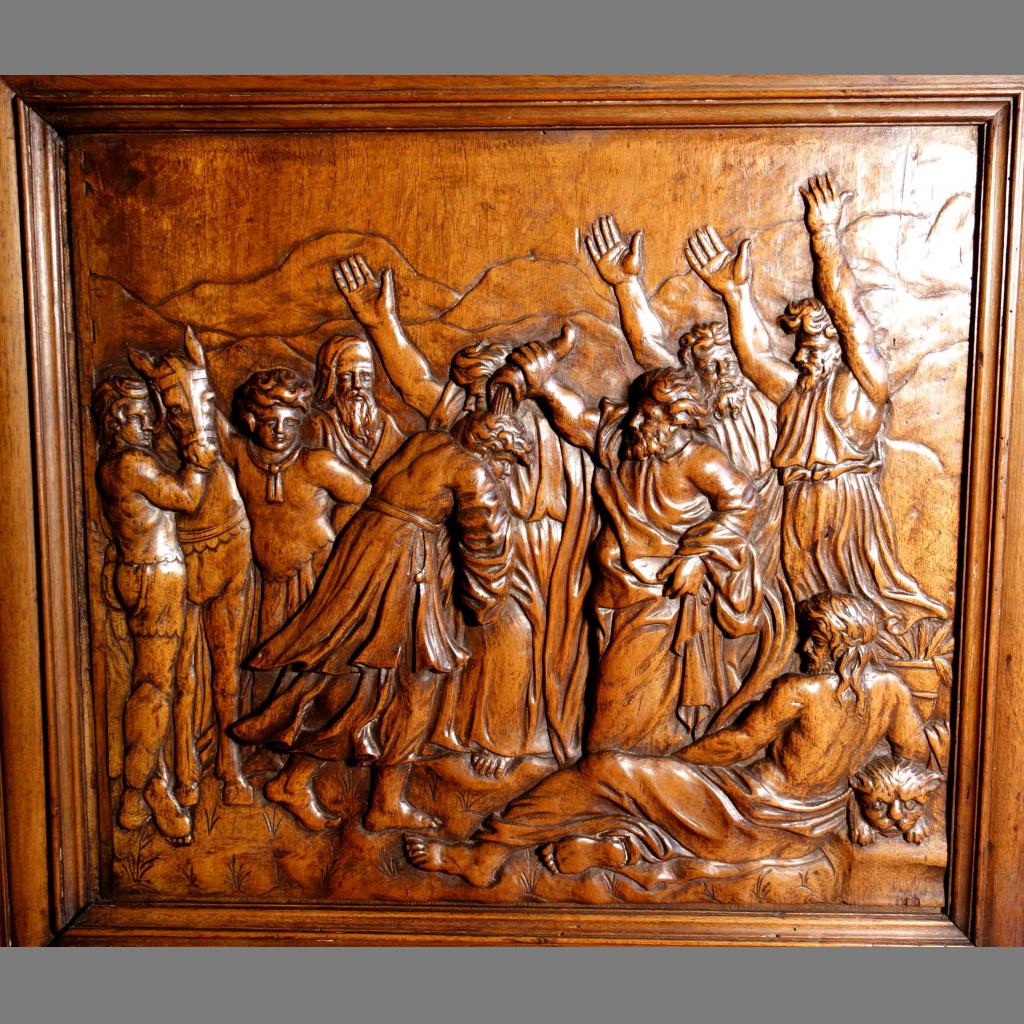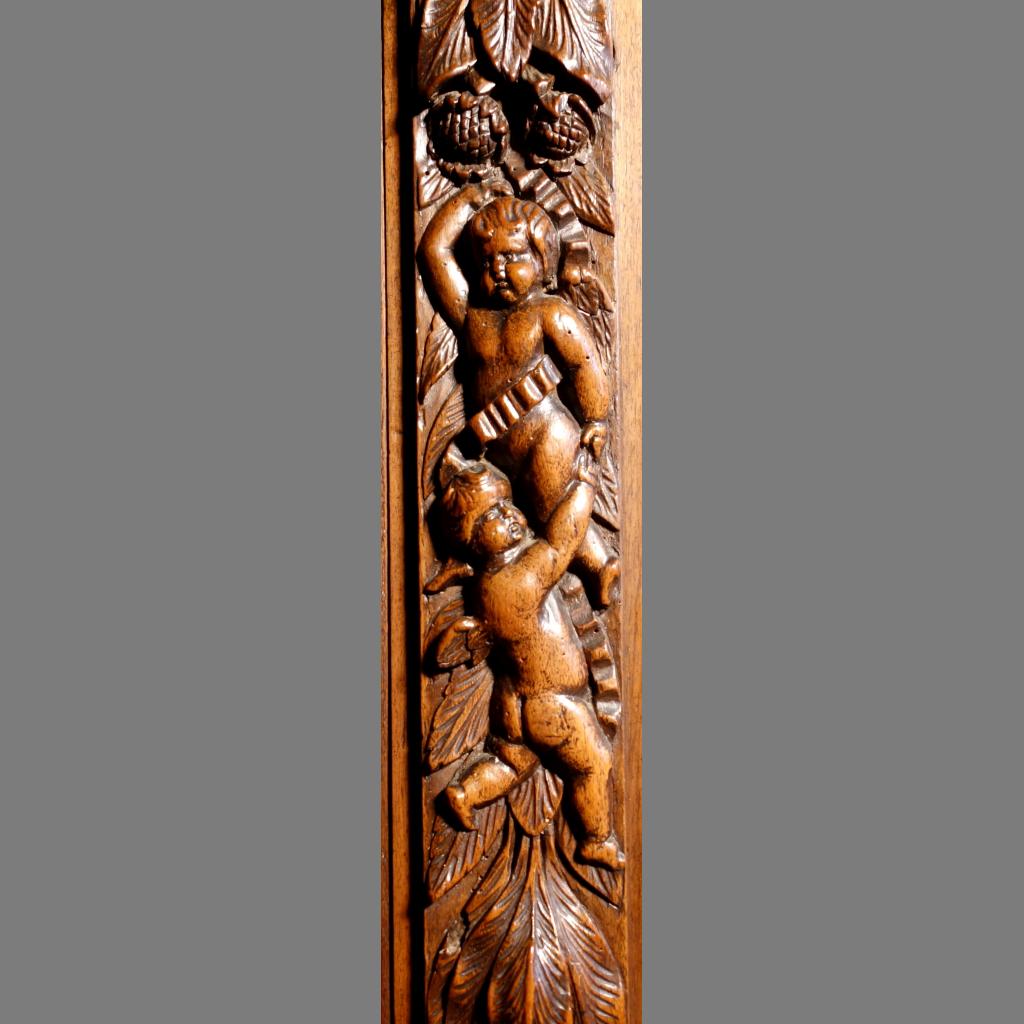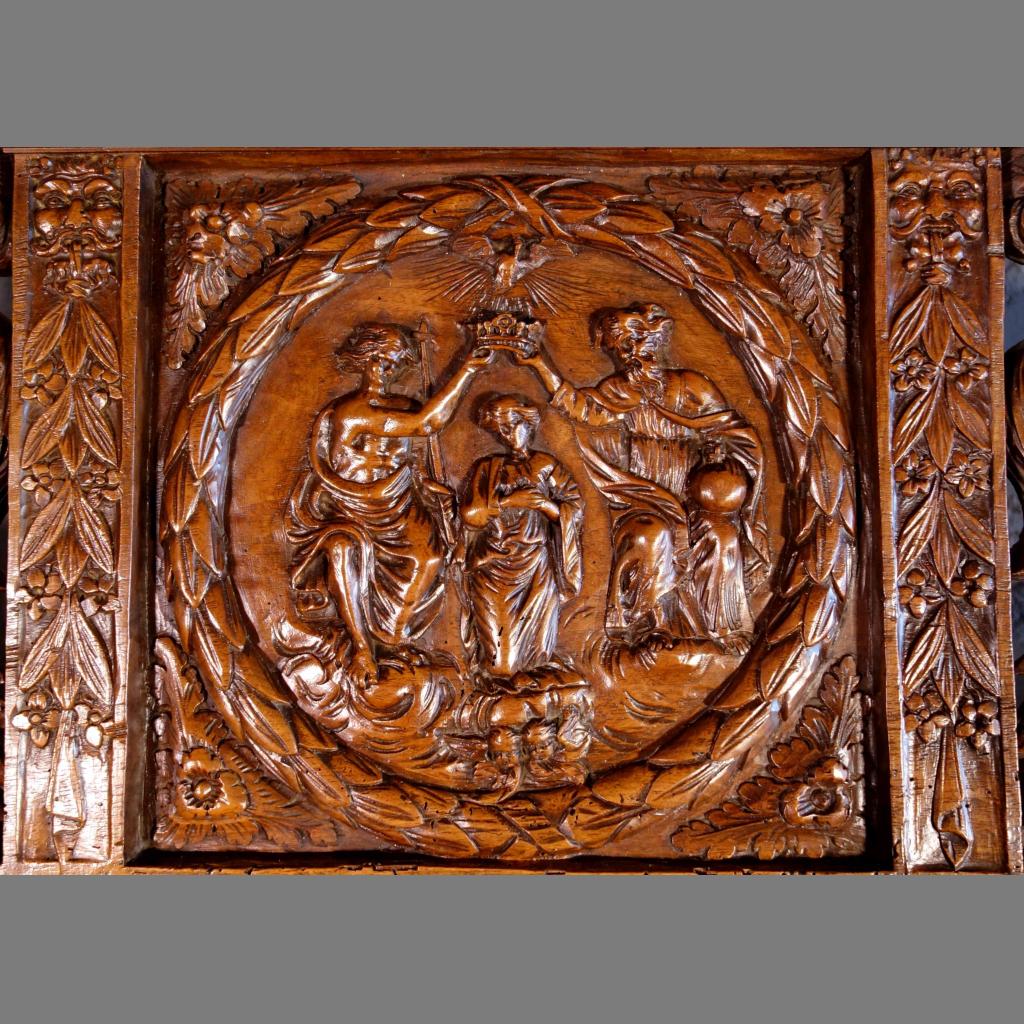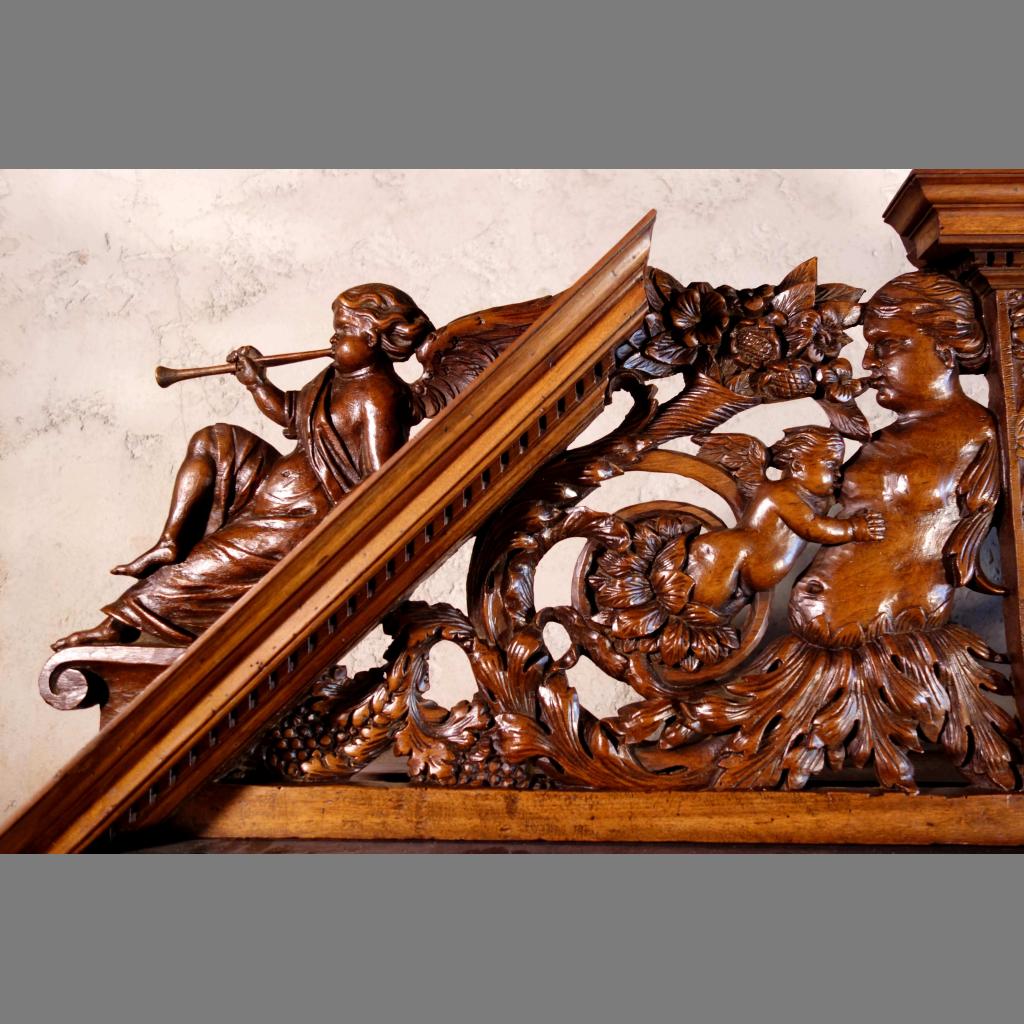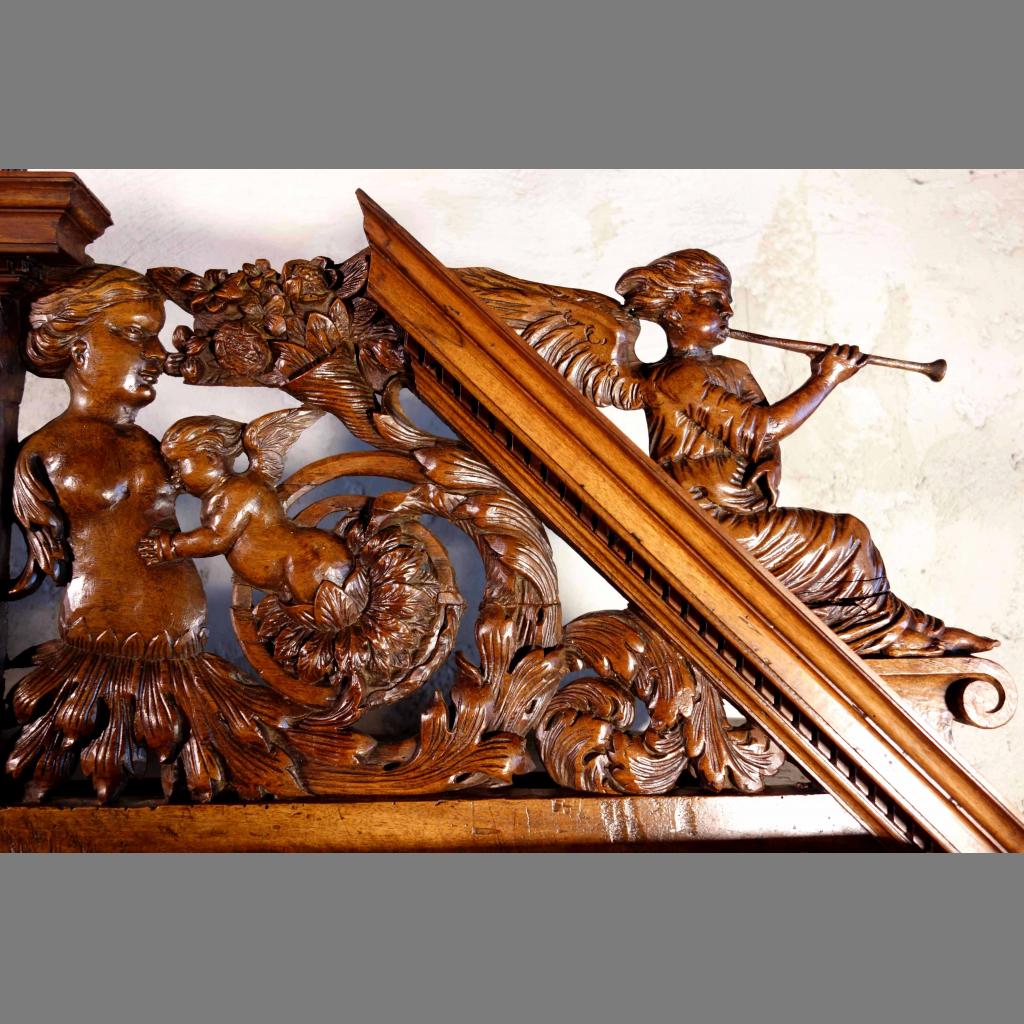Lire la suite...
Languedoc wardrobe from the 17th century: History of Solomon
BuyRequest detailsSur demande € (port +200€)
Armoires,
Renaissance,
XVII
Rare figured cabinet from the Bas-Languedoc region.
This type of cabinet is part of a select group of richly carved regional furniture representing the social and financial success of the nobility and upper bourgeoisie of the 17th century.
We present here a summary description of this piece. We strongly encourage the reader to consult the complete file with numerous photos and details by clicking on the following link:
Présentation de l’armoire biblique de Salomon en dossier PDF
In the 17th century, Bas-Languedoc was a crossroads of artistic trends, between Northern Europe and Italy. In a context of economic development in this region, the wealthiest nobles called on talented Master carpenters and Master sculptors to create a few examples, all unique, of these impressive cabinets, also called cabinets in the 17th century.
Some of these pieces are notably kept at the Musée du Vieux Nîmes. We will quote Martine Nougarède, Chief Curator of the said Museum: these Languedoc cabinets are “…rare, produced over a specific period of time, frequent in a limited region, most of the time made of walnut with very rich historical decorations in bas-reliefs [… ] they have all the criteria that make up the value of regional furniture. »
Presenting mythological or biblical themes such as Genesis, the story of Jacob, the life of the Virgin... The one we are presenting has the story of Solomon as its theme. Note that each theme was chosen by the sponsor of the Cévennes firm according to his personality and could translate the values that the family clan wanted to highlight.
This figured cabinet is part of the category of historic cabinets, which stand out from their peers which simply feature plant decor. In richly molded, carved and openwork walnut, it presents a large number of relief sculptures. The structure is divided into a central part made up of 6 panels depicting the biblical story of King Solomon on two doors. These two doors are framed by richly carved frames and a false frame over their entire height. The cabinet has at its top a cornice and an abundantly openwork pediment.
The decorative repertoire is rich, expressive, abundant. Its main objective is to impress, to recall the success of the owner as well as his prestige. The frames are sculpted with falling flowers and fruits, putti and topped with busts of Atlanteans and hamadryads which recall the productions of Hugues Sambin. The cornice is decorated in bas-relief with putti in acanthus scrolls and two musical cherubs. The pediment has in its center a laureate medallion representing the coronation of Christ by Saint John the Baptist and God the Father, surmounted by the Holy Spirit dove. This medallion is framed by female busts breastfeeding cherubs in a decoration of cornucopias and fruit scrolls. At the ends two angels sound trumpets. Finally, the whole is topped off with two musical cherubs and a bouquet. The sides are simple panels, one of the characteristics of Sumène cabinets detailed in the complete file.
The scenes from the life of Solomon are partly taken from engravings by Nicolas Chapron, themselves made from paintings of the Vatican Lodges by Raphael. This is an important source of inspiration for the Master sculptors of the 17th century. Note that the chronology of the scenes in the Sumène cupboards is rarely respected.
From left to right and top to bottom:
1.The Judgment of King Solomon.
2.Solomon welcomes the Queen of Sheba to Jerusalem, who brings him a large number of gifts including gold.
3.The prophet Elijah, whose ministry takes place just after the death of Solomon, is supplied by ravens.
4.Hiram, King of Tyre, sends his messenger to Solomon to inform him of his participation in the construction of the Temple thanks to his wooden resources.
5.The construction of Solomon's Temple.
6.The anointing of Solomon by the priest Zadok.
The theme of the Judgment of Solomon is particularly popular among the legal professions. This may give us a clue as to the nature of the sponsor of this Cévennes firm.
This biblical cabinet has all the characteristics of an extremely rare piece on the market. A historic cabinet, it is one of the first productions with refined sculptures and intended for an elite clientele, it is not simply decorated with plant decorations. The piece was not made up of different elements as we have noticed on certain quality furniture in the tradition of Languedoc cabinets but which have undergone modifications or are the result of assembly. Unlike other Cévennes cabinets, the one we present has its pediment topped with all the elements present originally such as the cherubs or the bouquet. We can assume that the fragility of the pediment and the height of these cabinets are the cause of a customary absence of these elements in height. It is worth noting a reinforcement of the pediment as well as some customary restorations to the lateral parts of the leaves at the level of the upper hinges, another customary restoration to the right angle of the lower crossbar as well as the end of the angels' trumpets winged.
Height: 285 cm
Width: 183 cm
Depth: 58.5 cm
Bibliography:
-Le mobilier du Moyen-âge et de la Renaissance en France par Jacques Thirion.
-Les armoires figurées du Bas-Languedoc par Martine Nougarède, Pascal Trarieux, Laurent Puech, Daniel Travier, Alexandre Cheval et Jacuqes Thirion.
-Mobilier provençal par Edith Mannoni.
